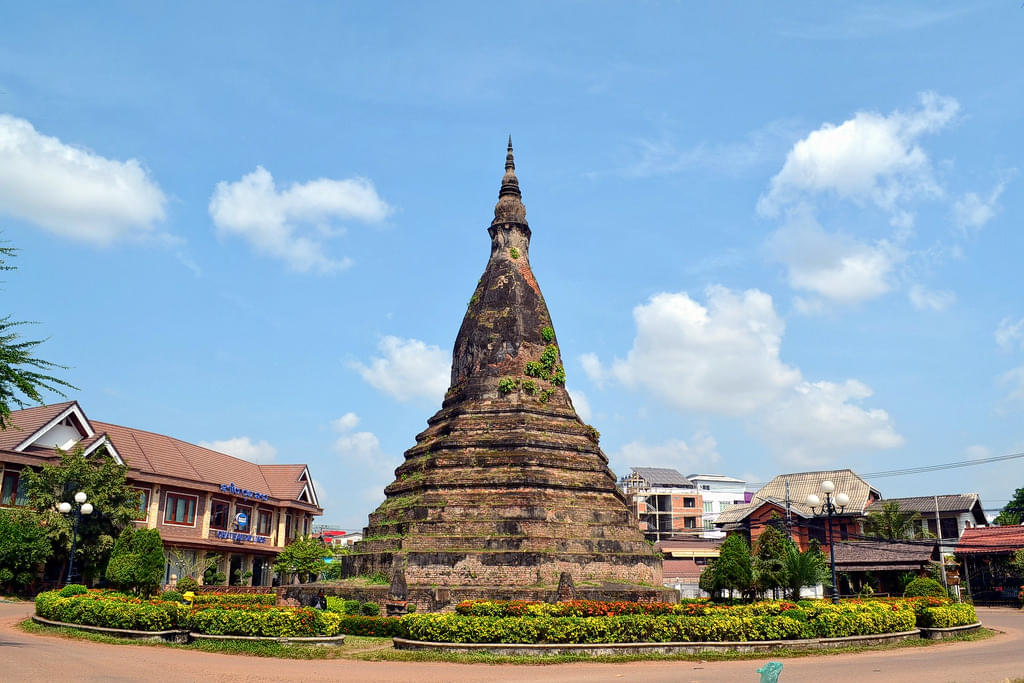About Black Stupa (That Dam)
That Dam, or black stupa, is located on a quiet roundabout not far from Talat Sao (the morning market) and the American Embassy. That in Laotian refers to an inverted bell shape (or unopened lotus flower) structure that usually contains relics of the Buddha. Legend has it that a seven-headed water serpent – a ‘Naga’ lived here to protect the stupa that was once covered in pure gold.During the Siamese-Laotian war in the 1820s, the gold was pillaged and taken to Siam, now Thailand, leaving the legacy that is the black stupa today. Known as the ‘Black Stupa', many locals believe this mythological structure was once inhabited by a seven-headed dragon (now dormant) that stood to protect the city from the threat of the Siamese.
Highlights : Known as the ‘Black Stupa', many locals believe this mythological structure was once inhabited by a seven-headed dragon (now dormant) that stood to protect the city from the threat of the Siamese.
Location: Chantha Khoumane Road, Vientiane
Tourism Board Alliances
All About Vientiane Trip
Popular Related Attractions
First Thai-Lao Friendship Bridge
The First Thai–Lao Friendship Bridge is a vital international crossing over the Mekong River, linking Nong Kha ...Read More
Ho Pra Keo
This is also written in many different ways like Haw Phra Kaew or Hoe Pha Keo and others. This was formally a ...Read More
Vat That Khao
This place is situated right beside a place called Vat That Luang which is believed to be the most sacred and ...Read More
Wat Chan
To view Thailand in a completely new way, one needs to go through all the unseen and unvisited places in Thail ...Read More
Vientiane City Pillar Shrine
This new shrine was finished in the year of 2012, and the contractor handed it over to the Information Ministr ...Read More
The Presidential Palace
The presidential palace is often another name for the residence officially booked for the presidents in differ ...Read More
More Vientiane Attractions
Lao People's Army MuseumLao Textile MuseumWat SokpaluangWat Ong TheuPhou Khao Khouay National ParkWat MixayWat Ho Phra KaewVientiane Pha That LuangPatuxai Victory MonumentWat Si MuangCope Visitor CentreWat SisaketMekong Riverside ParkBuddha ParkThat LuangVang ViengHouey Hong Vocational Training Centre For Women
Popular Related Destinations
Why Choose Thrillophilia
Best Domestic Packages
Ladakh Tour PackagesHimachal Tour PackagesKashmir Tour PackagesRajasthan Tour PackagesAndaman Tour PackagesUttarakhand Tour PackagesGoa Tour PackagesSpiti Valley Tour PackagesNorth India Tour PackagesSouth India Tour PackagesNorth East Tour PackagesIndia Tour PackagesDelhi Tour PackagesOoty Tour PackagesGangtok Tour PackagesChikmagalur Tour PackagesSikkim Tour PackagesShimla Tour PackagesManali Tour PackagesRishikesh Tour PackagesMeghalaya Tour PackagesJim Corbett Tour PackagesMussoorie Tour PackagesArunachal Tour PackagesKerala Houseboat PackagesDarjeeling Tour PackagesLeh Ladakh Bike Trip PackagesAuli Tour PackagesNainital Tour PackagesKedarnath Tour PackagesCharDham Yatra PackagesDharamshala Tour PackagesWayanad Tour PackagesKerala Tour PackagesJaipur Tour PackagesJodhpur Tour PackagesUdaipur Tour PackagesGolden Triangle Tour PackagesMount Abu Tour PackagesRanthambore Tour PackageCordelia Cruise PackagesMunnar Tour PackagesCoorg Tour PackagesShillong Tour PackagesMahabaleshwar Tour PackagesOoty Tour PackagesKarnataka Tour PackagesSrinagar Tour PackagesDehradun Tour PackagesLonavala Tour Packages
Best International Packages
Maldives PackageBali Tour PackagesDubai Tour PackagesEurope Tour PackagesSwitzerland Tour PackagesSingapore Tour PackagesThailand Tour PackagesBhutan Tour PackagesSri Lanka Tour PackagesMauritius Tour PackagesSeychelles Tour PackagesBangkok Tour PackagesPattaya Tour PackagesGreece Tour PackagesParis Tour PackagesLondon Tour PackagesPhuket Tour PackagesNorway Northern Lights TourFinland Tour PackagesAmsterdam Tour PackagesItaly Tour PackagesIceland Tour PackagesTurkey Tour PackagesNorway Tour PackagesSpain Tour PackagesGermany Tour PackagesIstanbul Tour PackagesNepal Tour PackagesMalaysia Tour PackagesVietnam Tour PackagesAustralia Tour PackagesSouth Africa Tour PackagesJapan Tour PackagesEgypt Tour PackagesPhilippines Tour PackagesHong Kong Tour PackagesIreland Tour PackagesAfrica Tour PackagesRussia Tour PackagesKenya Tour PackagesPrague Tour PackagesMasai Mara PackagesAntarctica Tour PackagesNew Zealand Tour PackagesSweden Northern Lights PackagesDenmark Tour PackagesIsrael Tour PackagesCambodia Tour PackagesJordan Tour PackagesTanzania Tour PackagesSantorini Tour PackagesAustria Tour PackagesCroatia Tour Packages
